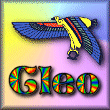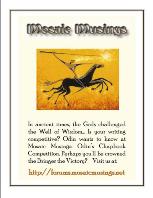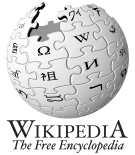 Sep 16 09, 16:32 Sep 16 09, 16:32
Post
#1
|
|
|
Group: Praetorian Posts: 4,599 Joined: 4-August 03 From: Birmingham, England Member No.: 12 Real Name: Eira Needham Writer of: Poetry Referred By:Lori |
 IMGP2285.JPG ( 1.6MB )
Number of downloads: 6
IMGP2285.JPG ( 1.6MB )
Number of downloads: 6large eyes flutter among echinachea blooms - peacock butterfly ·······  ······· ·······Live one day at a time -it's simpler that way.
Laugh loud & often - it's medicinal. Write from the heart - it's therapeutic. Beauty comes from within - the outer is just skin! Nominate a poem for the InterBoard Poetry Competition by taking into careful consideration those poems you feel would best represent Mosaic Musings. For details, click into the IBPC nomination forum. Did that poem just captivate you? Nominate it for the Faery award today! If perfection of form allured your muse, propose the Crown Jewels award. For more details, click here! MM Award Winner   |
|
|
|
 |
Replies
 Sep 17 09, 15:10 Sep 17 09, 15:10
Post
#2
|
|
|
Group: Administrator Posts: 18,892 Joined: 1-August 03 From: Massachusetts Member No.: 2 Real Name: Lori Kanter Writer of: Poetry & Prose Referred By:Imhotep |
I've also heard the syllables be referred to as Onji : In traditional Japanese, the haiku was often written in one long string, from top to bottom, using 17 onji (sound-symbols), the shortest unit of meaning. These onji were usually divided into 3 sections, with the middle one being slightly longer than the others; a pause at the end of the first or second section often divided the haiku into two thoughts or images which contrasted or combined to make a striking perception, usually involving nature. Some call this the Haiku Moment.
More tidbits from the web: Early translators, assuming that onji equaled syllables in our language (they do not), decided the English equivalent should be 3 lines containing 5-7-5 syllables respectively. Many poets still look for haiku in that pattern, though occasionally today’s verses may have from 1 to 5 lines and a varying number of syllables. Not all classical Japanese haiku had 17 onji, let alone 17 “syllables,” so if we insist on that pattern, it is out of habit, not out of respect for the original. ·······  ······· ·······"It's a dangerous business, Frodo, going out your door. You step into the Road, and if you don't keep your feet, there is no knowing where you might be swept off to." ~ J.R.R Tolkien, The Lord of the Rings
Collaboration feeds innovation. In the spirit of workshopping, please revisit those threads you've critiqued to see if the author has incorporated your ideas, or requests further feedback from you. In addition, reciprocate with those who've responded to you in kind. "I believe it is the act of remembrance, long after our bones have turned to dust, to be the true essence of an afterlife." ~ Lorraine M. Kanter Nominate a poem for the InterBoard Poetry Competition by taking into careful consideration those poems you feel would best represent Mosaic Musings. For details, click into the IBPC nomination forum. Did that poem just captivate you? Nominate it for the Faery award today! If perfection of form allured your muse, propose the Crown Jewels award. For more information, click here!  "Worry looks around, Sorry looks back, Faith looks up." ~ Early detection can save your life. "Worry looks around, Sorry looks back, Faith looks up." ~ Early detection can save your life.MM Award Winner  |
|
|
|
Posts in this topic
 Eisa haiku Sep 16 09, 16:32
Eisa haiku Sep 16 09, 16:32 
 ace Eisa:
Beautiful picture..beautiful lines.
O... Sep 16 09, 17:56
ace Eisa:
Beautiful picture..beautiful lines.
O... Sep 16 09, 17:56 
 Cleo_Serapis Hi Snow,
Lovely picture is right! WOW!... Sep 17 09, 08:58
Cleo_Serapis Hi Snow,
Lovely picture is right! WOW!... Sep 17 09, 08:58 
 Larry Hello Snow,
Loved the picture and the haiku. I, ... Sep 17 09, 14:16
Larry Hello Snow,
Loved the picture and the haiku. I, ... Sep 17 09, 14:16 
 Peggy Carpenter Harwood Hi Snow,
I like the haiku, but don't particul... Sep 18 09, 07:51
Peggy Carpenter Harwood Hi Snow,
I like the haiku, but don't particul... Sep 18 09, 07:51 
 Thoth Hi snow,
very inspiring, especially the photo... Sep 18 09, 08:39
Thoth Hi snow,
very inspiring, especially the photo... Sep 18 09, 08:39 
 ohsteve Snow very lovely picture and poem. I no longer bel... Sep 19 09, 20:12
ohsteve Snow very lovely picture and poem. I no longer bel... Sep 19 09, 20:12 
 4rum Ya know, this little visit and this little poem an... Dec 7 09, 07:36
4rum Ya know, this little visit and this little poem an... Dec 7 09, 07:36 1 User(s) are reading this topic (1 Guests and 0 Anonymous Users)
0 Members:
  |

|
Lo-Fi Version | Time is now: 15th October 2025 - 11:20 |


















